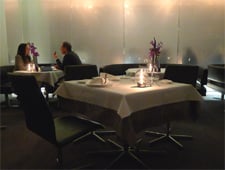The heavy sauces that have traditionally accompanied game are becoming increasingly rare. Game itself is hard to come by these days due to issues with EU food safety hygiene regulations. Gone are the days in Europe when freshly hunted wild boar was displayed proudly in open air markets, when customers could choose their fowl from cages and rabbits from hutches. For many, the aroma of a woodcock slowly roasting over an open fire is already a distant memory. The hunt for fowl is a nostalgic activity that coincides with the return of migratory birds. Due to the current food safety crisis involving domestic poultry, the consumption of feathered game has decreased. Despite this decline, chefs on both sides of the Atlantic are still big game fans and debating how best to sauce it. Among the schools of thought are those that create sauces with an animal-based consommé, those that favor a bouillon-based or vegetable purée substitute and others that are still exploring unknown territory. As recently as thirty years ago, the sixth and seventh commandments of “nouvelle cuisine,” according to Gault Millau and Gayot, called for new rules when it came to sauces: “Thou shall avoid marinades, faisandages (aging) and fermentations,” and “Thou shall eliminate brown and white sauces.” Meanwhile the English noted that “a sauce does not nourish the stomach but the palate,” implying that sauce is not always a positive addition to a dish.
In the 1990s, when he was still cooking game, Alain Passard of the celebrated Arpège in Paris demonstrated that a simply and slowly roasted piece of wild boar was of culinary interest even without aging and marinating. Today, New York chefs are trying the minimalist route with jus, arugula purée that adds an acidic accent, beet and quince for a sweet note, a hint of vinegar or a drop of sesame oil. Two such chefs, Thomas Keller of Per Se and Gabriel Kreuther, the rising chef of The Modern, the new restaurant in the Museum of Modern Art, are even seducing their customers with farm-raised game.
The most experienced cook in this area is Jean-Georges Vongerichten, the Franco-New York chef whose Parisian restaurant, Market, opened in 2001. Vongerichten offers a medallion of venison with no jus and no sauce whatsoever. The piece of game is simply pan-seared and served with a poached pear, crispy bacon and a subtle mixture of spices. The taste of the game remains intact and is best accompanied by a Syrah and not a Pinot; in other words, with a Côtes-du-Rhône and not a Bourgogne. Fans of big game prepared according to the strictest of traditions can always have a meal in Paris at Gérard Besson, who prepares fowl and venison as well as admirable stews.
|
A brut non-vintage Champagne from one of the five oldest Champagne houses.
Read the article.
Best wines to pair your Thanksgving Dinner.
Check the list.
 Over the years, we have been electing restaurants to be on GAYOT's Yearly Restaurant Awards.
Over the years, we have been electing restaurants to be on GAYOT's Yearly Restaurant Awards.Check the list.

















